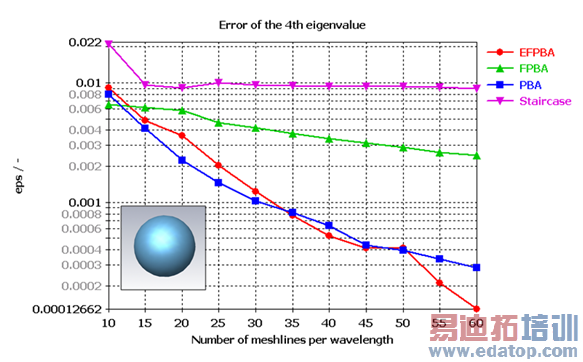- 易迪拓培训,专注于微波、射频、天线设计工程师的培养
CST2013: Hexahedral Mesh
For the spatial discretization with a hexahedral grid, the Finite Integration Method (FI-Method) in conjunction with the Perfect Boundary Approximation (PBA) is used. The simulated structure and the electromagnetic fields are mapped to hexagonal mesh.
The mesh is generated by the automatic mesh generator. This generator, an expert system in connection with optional adaptive mesh refinement features, ensures a good compromise between the need of an accurate structure and field discretization and a short simulation time.
The following topics explain how the mesh influences the simulation and what requirements should be fulfilled to obtain a good mesh.
Mesh and Simulation
The mesh influences the accuracy and the simulation time of the solver.
Mesh and Structure Approximation
PBA mesh: Besides the sufficient sampling of the fields, it is very important to obtain a good approximation of the structure within the mesh. This is performed by Perfect Boundary Approximation (PBA), which ”maps” the structure from the continuous world into the mesh of the discrete world.
Four different mesh types are available, providing different accuracy and performance properties: PBA, FPBA, FPBA with enhanced accuracy technique and Staircase.
Starting with CST STUDIO SUITE version 2012, the FPBA mesh type uses by default the accuracy enhanced technique. This technique ensures an even better geometric accuracy than FPBA alone, which is reflected in a higher accuracy in S-Parameters, eigenfrequency and field results.
The figure below illustrates the convergence of the result for various hexahedral mesh types available in CST STUDIO SUITE, on an example with analytic solution: the computation of one eigenvalue for a spherical resonator. It is obvious that the enhanced-accuracy FPBA (EFPBA) quickly leads to a very good accuracy: the error is below 0.2% already on a relatively small mesh of 10,000 mesh cells. The convergence speed of the enhanced-accuracy FBPA is similar to that of the PBA technique, whereby FPBA additionally offers extreme robustness for imported geometries.

The FPBA technique with enhanced accuracy might require more resources (memory/cpu) than the classical FPBA for the same number of meshcells. On the other hand, the same accuracy as in previous versions can be typically achieved with less meshnodes.
However, a somewhat less accurate, but also less resource-intensive solution may be sometimes desired, e.g. at the beginning of a new design, when a large number of quicker simulations might be needed for finding a reasonably good initial design. In such situations, the macro Home: Macros  Macros
Macros  Solver
Solver  T-Solver
T-Solver  Mesh and Loss Handling - Legacy defaults can be used to restore the default algorithms to those used in older versions of CST STUDIO SUITE.
Mesh and Loss Handling - Legacy defaults can be used to restore the default algorithms to those used in older versions of CST STUDIO SUITE.
Staircase mesh: In addition to the PBA mesh, a classic staircase mesh is provided. Choose the staircase mesh for imported structures that are not solids or that cannot be healed.
Structure Treatment by Automesh: To make sure that the structure is represented as well as possible, the automatic mesh generator tries to create the mesh such that critical structure elements are located on mesh lines or planes. This is accomplished by creating a number of fixpoints and densitypoints. In doing this, the mesh generator creates mesh lines that are very close to each other. For a very accurate discretization of the structure these mesh lines might be necessary, but small local mesh steps increase the simulation time.
To avoid such problems, a ratiolimit may be defined. This forces the automatic mesh generator to produce a mesh where the absolute ratio between the highest and the smallest distance between mesh lines is below the ratiolimit value. The default value of 10 is very often a good compromise to start with (See Mesh Properties Dialog).
Mesh and PEC Edges: At PEC edges, you theoretically obtain singularities in the electromagnetic fields. This means that the fields vary significantly near such edges.
To obtain a good approximation of this behavior, the most straight-forward method is to increase the spatial sampling rate there (see Special Mesh Properties – Refinement).
A second, more sophisticated possibility is to use the corner correction method. The corner correction uses a singularity model for PEC edges. It is based on analytical models to obtain a better discretization of the electromagnetic fields (see Special Mesh Properties – General).
Adaptive Meshing
For some structures the automatic mesh generator might not find an optimal mesh. In these cases, an adaptive meshing procedure might be more successful. This procedure simulates the structure a few times and improves the mesh from run to run.
There are two different strategies for adaptive meshing. One is based on an expert system and the other on the different field energies within the calculation domain.
CST微波工作室培训课程套装,专家讲解,视频教学,帮助您快速学习掌握CST设计应用
上一篇:CST2013: Mesh Problem Handling
下一篇:CST2013: Multilayer Solver Problem Handling
 最全面、最专业的CST微波工作室视频培训课程,可以帮助您从零开始,全面系统学习CST的设计应用【More..】
最全面、最专业的CST微波工作室视频培训课程,可以帮助您从零开始,全面系统学习CST的设计应用【More..】
频道总排行
- CST2013: Mesh Problem Handling
- CST2013: Field Source Overview
- CST2013: Discrete Port Overview
- CST2013: Sources and Boundary C
- CST2013: Multipin Port Overview
- CST2013: Farfield Overview
- CST2013: Waveguide Port
- CST2013: Frequency Domain Solver
- CST2013: Import ODB++ Files
- CST2013: Settings for Floquet B
